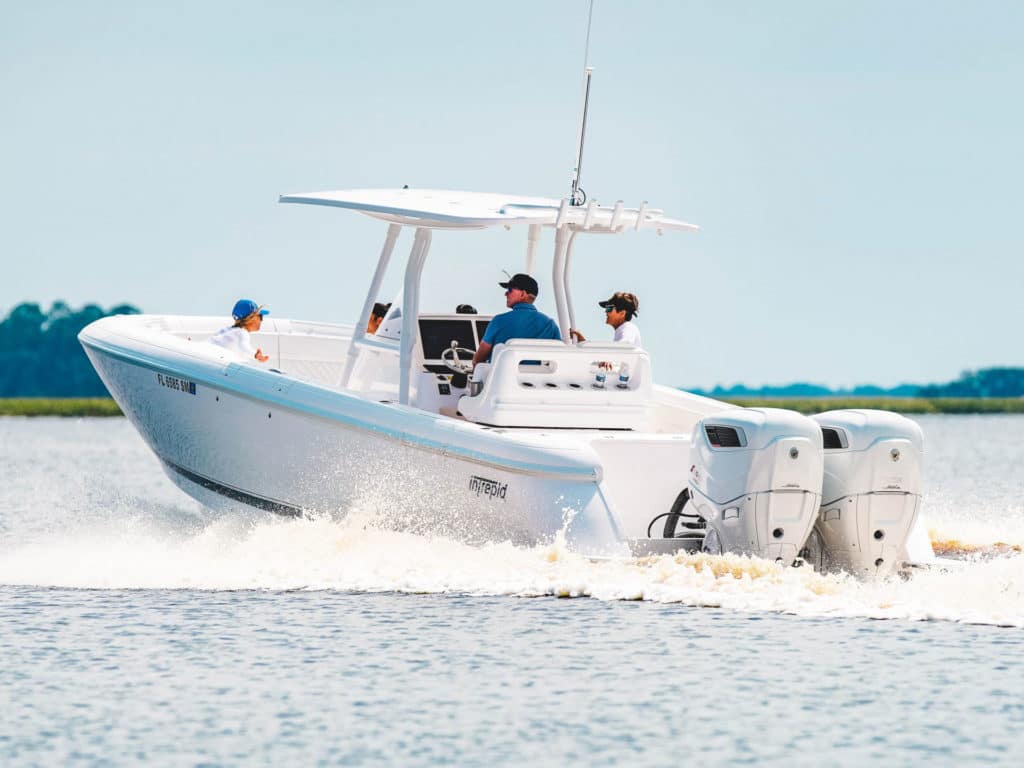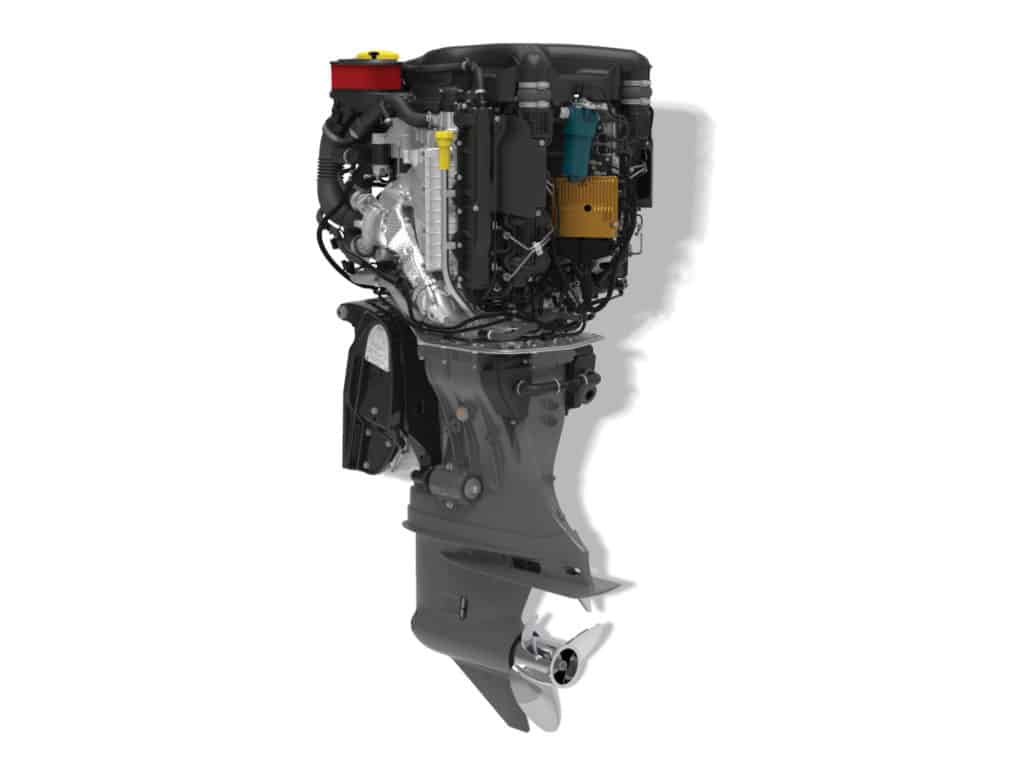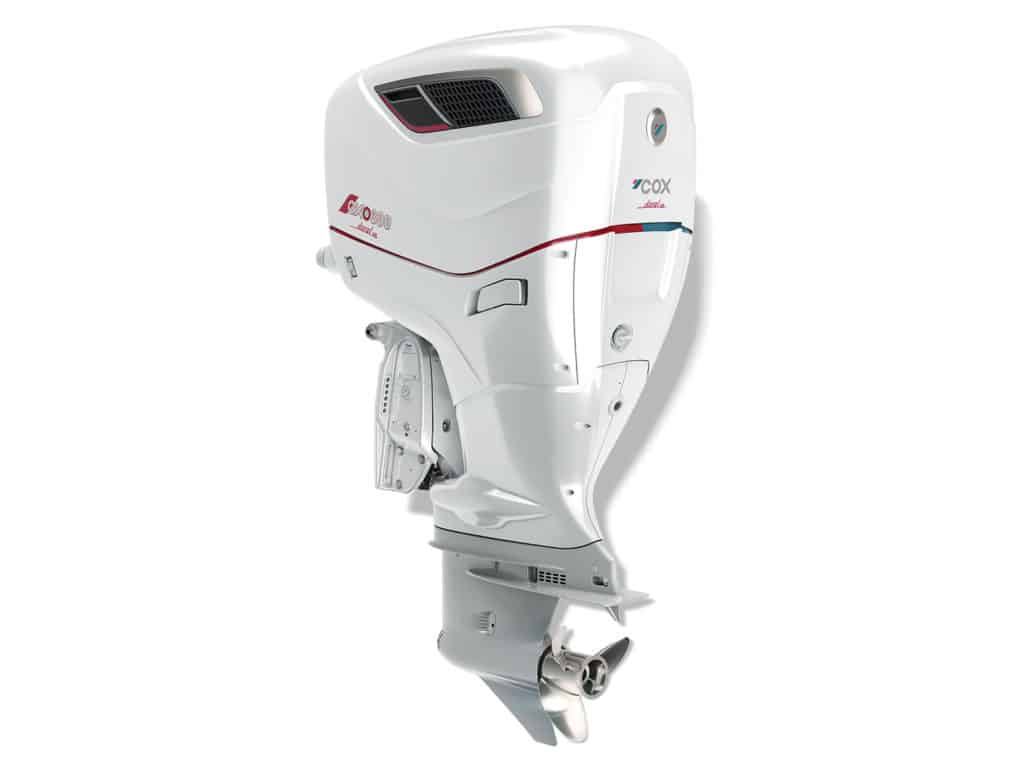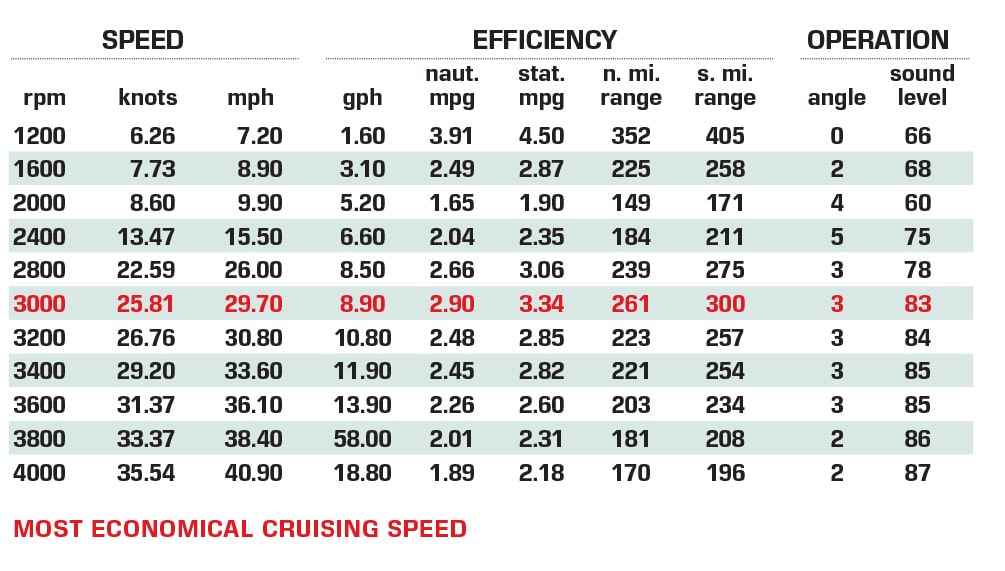
Diesel-fueled engines have long attracted boaters with the prospect of great efficiency, range, durability, torque and safety thanks to the low volatility of this fuel. With few exceptions, however, choices in marine diesel power had been limited to inboards in the past, especially in the higher horsepower categories.
But in recent years, a number of diesel-fueled outboards have emerged. The latest to hit the market is the Cox Powertrain CXO300, and we put one of these 300 hp engines through its paces in the waters off Long Beach, California.
My nose served as the initial test tool as we idled through the no-wake zone. I caught nary a whiff of diesel exhaust smell. What’s more, the motor was surprisingly quiet, with none of the clackity-clack typical of diesel engines. In fact, from the helm of the four-person cabin on the Safe Boats S25 aluminum foam-collared boat used as a test platform, it registered just 66 decibels on the A-scale while in gear at idle. This model is no longer in the Safe Boats line, having been replaced by the Safe Boats 25 Full Cabin for eight people.

For perspective, the CXO300′s sound level at idle is slightly higher than single gas outboard motors, which typically emit between 61 and 65 dB(A) at idle at the helm. On the other hand, while testing the Mag Bay 42 with twin Volvo Penta D-13 turbo-diesel inboards, sound levels rumbled at 83 dB(A) at idle.
Cox has invested a decade of development in the CXO300. The twin-turbocharged four-stroke V-8 powerhead displaces 4.4 liters and is served by a common-rail fuel-injection system. Purpose-built for marine use, the engine is mounted vertically like today’s gas outboards. Another major diesel outboard brand—Swedish-built OXE—uses horizontally mounted, automotive-based diesel powerheads. Its 300 hp model, for example, sports an inline-six-cylinder 3.0-liter turbocharged diesel powerplant from BMW, which drives the propeller via a series of heavy-duty belts and pulleys.
The Cox 300 employs a conventional outboard drivetrain with a vertical drive shaft connecting the motor to the lower unit, which houses the forward and reverse gear system similar to most gas outboards. However, the drivetrain components are specially designed for commercial applications and oversize to handle the CXO300′s maximum torque of 480 foot-pounds at 4,000 rpm. For perspective, peak torque for a 300 hp gas outboard is around 380 foot-pounds, which is reached at 2,500 to 3,000 rpm, according to test data supplied by Cox. Cox says its industrial-grade design will help the engine last up to three times longer than comparable gas outboards.
Standard rigging for the CXO300 includes Dometic electronic throttle and shift controls, as well as Optimus electric steering. The 30-inch-shaft test engine was also rigged on a SeaStar jack plate, but we left it in the full down position because this proved to be the ideal engine height for optimal speed.
The wide-open throttle range for the CXO300 is 3,800 to 4,000 rpm, versus 6,000 rpm or higher for many of today’s gas outboards. Despite lower engine speed, diesel’s greater torque can turn a higher gear ratio and/or a larger-diameter propeller to convert that torque into boat speed. The gear ratio on our test engine was 1.46-to-1 turning a 19-inch-pitch PowerTech three-blade stainless-steel prop.
Safe Boats’ S25 accelerated from zero to 30 mph in an average time of 11.7 seconds, but speed really ramped up after about 4 seconds as the twin turbos kicked in. Time to plane was 4.5 seconds. Top speed was 40.9 mph at 4,000 rpm.

On test day, the S25′s PV780 Murphy engine display (part of the CXO300 rigging package) had not yet been set up to read gallons per hour, so we used data supplied by Cox Powertrain for the fuel-consumption data to calculate miles per gallon. Cox says the CXO300 offers at least 25 percent better range than a comparable gasoline outboard. That claim is hard to confirm without a direct comparison on the same boat under the same conditions. However, the CXO300 achieved its best fuel economy at 3,000 rpm and 29.7 mph with a burn rate of 8.9 gph, resulting in 3.3 mpg. That equates to a cruising range of 297 miles, based on 90 percent of the 100-gallon fuel capacity of the 6,992-pound S25 (weight includes motor, fuel and crew).
Sound levels at the helm of the S25 remained comparatively low as speed increased, registering 83 and 87 dB(A) at optimal cruising speed and wide-open throttle, respectively. For anglers, slow-trolling with the CXO300 will be an issue because the slowest speed we could achieve was 5 mph at 750 rpm with the 1.46-to-1 gear ratio. Most gas outboards will troll as slow as 1.5 to 2 mph at idle. The solution for the CXO300 is bumping the engine in and out of gear to slow the trolling speed.
Read Next: OXE Diesel Outboards
The CXO300 will be offered in three shaft lengths—25, 30 and 35 inches—in both black and white paint schemes. The listed weight is 881 pounds for the 30-inch-shaft model we tested. As a point of comparison, that is 57 percent heavier than Yamaha’s F300, which is listed at 562 pounds for its 30-inch-shaft model.
The CXO300 carries a suggested retail price of $55,000 and is available now. More than 150 units have already been sold around the world, according to Cox Powertrain.
How We Tested
- Engines: Single Cox Powertrain CXO300
- Drive/Prop: Outboard/PowerTech 16″ x 19″ 4-blade stainless steel
- Gear Ratio: 1.46:1 Fuel Load: 55 gal. Crew Weight: 600 lb.
Cox CXO300 Diesel Outboard Pricing and Specs
| Price: | $55,000 |
|---|---|
| Horsepower: | 300 |
| Displacement: | 4.4 liters |
| Weight: | 881 lb. (30-inch shaft) |
| Cylinders: | V-8 |
| Compression: | 16:1 |
| Torque: | 480 ft.-lb. |
| Aspiration: | Twin turbochargers with common-rail EFI |
| Gear Ratio: | 1.46:1 or 1.23:1 |
| Emission Compliance: | EPA Tier III |
Speed, Efficiency, Operation

Cox Powertrain Ltd. – Shoreham-by-Sea, United Kingdom; +44(0)1273 454 424
Safe Boats S25 Specs
| LOA: | 25’0″ |
|---|---|
| Beam: | 8’6″ |
| Draft: | 1’8″ |
| Displacement: | 5,196 lb. (dry, no engine) |
| Transom Deadrise: | 25 degrees |
| Fuel Capacity: | 100 gal. |
| Bridge Clearance: | NA |
| Max Horsepower: | 500 |
| Available Power: | Single or twin outboards to 500 hp total |
Safe Boats International – Bremerton, Washington; 360-674-7161; safeboats.com









